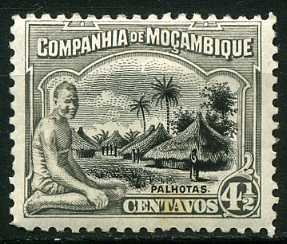Stamp: Native and village (Mozambique Company 1924)
Native and village (Mozambique Company 1924)
01 January (Mozambique Company ) within release Landscapes goes into circulation Stamp Native and village face value 4½ Mozambican centavo
| Stamp Native and village in catalogues | |
|---|---|
| Stanley Gibbons: | Sg: MZ-C 227B |
| Afinsa-Mundifil: | Afi: MZ-C 144a |
Stamp is square format.
Also in the issue Landscapes:
- Stamp - Sisal plantation face value 10;
- Stamp - View of Beira face value 2;
- Stamp - Beira railway face value 7;
- Stamp - Boat with sail on River Buzi face value 2½;
- Stamp - Cattle Breeding (Bos primigenius taurus) face value 50;
- Stamp - Cattle Breeding (Bos primigenius taurus) face value 60;
- Stamp - Cocos nucifera face value 30;
- Stamp - Cocos nucifera face value 40;
- Stamp - Corn field face value 1;
- Stamp - Corn Field face value 3;
- Stamp - Cotton plantation face value 12;
- Stamp - Cotton plantation face value 8;
- Stamp - Elephants Holding Coat Of Arms face value 1;
- Stamp - Kaoutsouk harvest face value 1½;
- Stamp - Native and Ivory face value ½;
- Stamp - Native and Village face value ¼;
- Stamp - Native and village face value 4½;
- Stamp - Orange harvest face value 7½;
- Stamp - Sisal plantation face value 80;
- Stamp - Sugar refinery face value 2;
- Stamp - Tribunal of Beira (Law Court) face value 20;
- Stamp - View of Beira face value 5;
Stamp Native and village it reflects the thematic directions:
A house is a single-unit residential building. It may range in complexity from a rudimentary hut to a complex structure of wood, masonry, concrete or other material, outfitted with plumbing, electrical, and heating, ventilation, and air conditioning systems. Houses use a range of different roofing systems to keep precipitation such as rain from getting into the dwelling space. Houses generally have doors or locks to secure the dwelling space and protect its inhabitants and contents from burglars or other trespassers. Most conventional modern houses in Western cultures will contain one or more bedrooms and bathrooms, a kitchen or cooking area, and a living room. A house may have a separate dining room, or the eating area may be integrated into the kitchen or another room. Some large houses in North America have a recreation room. In traditional agriculture-oriented societies, domestic animals such as chickens or larger livestock (like cattle) may share part of the house with humans.
The Arecaceae is a family of perennial, flowering plants in the monocot order Arecales. Their growth form can be climbers, shrubs, tree-like and stemless plants, all commonly known as palms. Those having a tree-like form are called palm trees. Currently, 181 genera with around 2,600 species are known,
most of which are restricted to tropical and subtropical climates. Most palms are distinguished by their large, compound, evergreen leaves, known as fronds, arranged at the top of an unbranched stem, except for the Hyphaene genus, who has branched palms. However, palms exhibit an enormous diversity in physical characteristics and inhabit nearly every type of habitat within their range, from rainforests to deserts.
Flora is the plant life occurring in a particular region or time, generally the naturally occurring or indigenous—native plant life. The corresponding term for animal life is fauna. Flora, fauna and other forms of life such as fungi are collectively referred to as biota. Sometimes bacteria and fungi are also referred to as flora, as in the terms gut flora or skin flora.



